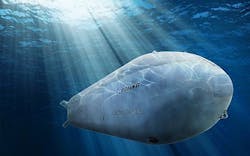Navy asks Boeing to build four long-endurance extra-large UUVs for long-range surveillance missions
Officials of the U.S. Naval Sea Systems Command in Washington announced a $43 million contract modification on Wednesday to the Boeing Defense, Space & Security segment in Huntington Beach, Calif., to build four Orca Extra-Large Unmanned Undersea Vehicles (XLUUVs).
Extra-large UUVs typically are autonomous mini-submarines that measure about seven feet in diameter -- sometimes larger. They are designed for launch from shore or from large military ships with well decks, or from large civil vessels with moon pools.
The modular-construction Boeing Orca XLUUV will be an open-architecture reconfigurable unmanned underwater vehicle (UUV) with the core vehicle providing guidance and control, navigation, autonomy, situational awareness, core communications, power distribution, energy and power, propulsion and maneuvering, and mission sensors, Navy officials say.
The Lockheed Martin Rotary and Mission Systems segment in Riviera Beach, Fla., also is designing prototype Orca XLUUV systems.
Related: DARPA asks industry for large unmanned undersea vehicle advanced payload delivery system
The Orca XLUUV will have well-defined interfaces for cost-effective future upgrades to capitalize on advances in technology and respond to threat changes. The Orca XLUUV will have a modular payload bay, with defined interfaces to support current and future UUV payloads.
XLUUVs, which are among the largest unmanned submersibles ever conceived, will be for long-endurance surveillance missions or undersea cargo vessels to deliver other sensor payloads and other UUVs.
These large unmanned undersea vehicles eventually could be used as motherships to deploy and recover smaller surveillance UUVs on far-flung reconnaissance, surveillance, or special warfare missions in the open ocean or along coastlines and inside harbors.
The Navy and the U.S. Defense Advanced Research Projects Agency (DARPA) in Arlington, Va., have involved Lockheed Martin and Boeing on a variety of large UUV projects such as the Large-Displacement Unmanned Underwater Vehicle (LDUUV) project.
An LDUUV typically is described as an autonomous submarine no larger than 80 inches in diameter. Future XLUUVs likely will be larger. Experience with the LDUUV will help inform concepts for using XLUUV.
story continues below
DARPA issued a solicitation two years ago for the Hunter program to develop a payload-delivery system from an extra-large UUV. The Hunter program, however, involves only the payload delivery system and not the extra-large UUV itself.
Hunter payloads could involve persistent-surveillance sensors, weapons, or other unmanned underwater vehicles (UUVs) and unmanned aerial vehicles (UAVs). They could involve persistent-surveillance sensors, weapons, or other UUVs and perhaps even unmanned aerial vehicles (UAVs).
The Navy's XLUUV project is moving enabling technologies forward that were developed originally in other projects such as the DARPA Hydra program to develop an unmanned submersible large enough to transport and deploy UAVs and UUVs stealthily in enemy territory to respond quickly to situations around the world.
Boeing has developed the Echo Voyager, a 51-foot large UUV that can reach depths of 11,000 feet and can operate independently for months underwater. Boeing unveiled the Echo Voyager in early 2016 and began sea trials of the unmanned undersea craft in summer 2017.
Boeing and Lockheed Martin both were involved in a DARPA project in 2015 ago called Blue Wolf, which focused on revolutionary underwater propulsion and drag-reduction technologies to enable manned and unmanned military undersea vehicles to move through the water faster and more energy-efficiently than ever before.
The Blue Wolf program demonstrated integrated underwater vehicle prototypes able to operate at speed and range combinations previously unachievable in fixed-size platforms, while retaining traditional volume and weight fractions for payloads and electronics.
Blue Wolf involved dynamic lift from winglets, body shaping, coatings, and novel drag reduction technologies applicable over various range and speed combinations to improve system energy efficiency.
In addition, Lockheed Martin has been involved in a U.S. Special Operations Command (SOCOM) Dry Combat Submersible (DCS) program to design an affordable mini-submarine able to transport Special Operations combat swimmers such as Navy SEALs covertly while minimizing swim time to keep the divers from becoming too exhausted to carry out their missions.
Lockheed Martin also has experience with the Navy's Remote Multi-Mission Vehicles (RMMV) UUVs for use in countermine warfare aboard the U.S. Navy's Littoral Combat Ship.
On this order Boeing will do the work in Huntington Beach, City of Industry, El Cajon, and Ontario Calif.; Virginia Beach, Va.; Waukesha, Wis.; East Aurora and Farmingdale, N.Y.; Concord and Attleboro, Mass.; Camden and Fairfield, N.J.; and Smithfield, Pa., and should be finished by June 2022.
For more information contact Boeing Defense, Space & Security online at www.boeing.com/company/about-bds, or Naval Sea Systems Command at www.navsea.navy.mil.
Ready to make a purchase? Search the Military & Aerospace Electronics Buyer's Guide for companies, new products, press releases, and videos
